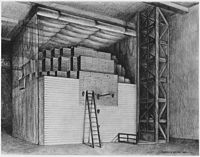
Photo from wikipedia
Condensed matter systems realizing Weyl fermions exhibit striking phenomenology deriving from their topologically protected surface states as well as chiral anomalies induced by electromagnetic fields. More recently, inhomogeneous strain or… Click to show full abstract
Condensed matter systems realizing Weyl fermions exhibit striking phenomenology deriving from their topologically protected surface states as well as chiral anomalies induced by electromagnetic fields. More recently, inhomogeneous strain or magnetization were predicted to result in chiral electric $\mathbf{E}_5$ and magnetic $\mathbf{B}_5$ fields, which modify and enrich the chiral anomaly with additional terms. In this work we develop a lattice-based approach to describe the chiral anomaly, which involves Landau and pseudo-Landau levels and treats all anomalous terms on equal footing naturally incorporating Fermi arcs. We exemplify its potential by i) physically interpreting the largely overlooked role of Fermi arcs in the covariant (Fermi level) contribution to the anomaly and ii) revisiting the factor of $1/3$ different between the covariant and consistent (complete band) contributions to the $\mathbf{E}_5\cdot\mathbf{B}_5$ term in the anomaly. Our framework provides a versatile tool for the analysis of anomalies in realistic lattice models as well as a source of simple physical intuition for understanding strained and magnetized inhomogeneous Weyl semimetals.
Journal Title: Physical Review B
Year Published: 2019
Link to full text (if available)
Share on Social Media: Sign Up to like & get
recommendations!